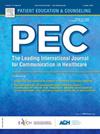Patients’ requests and physicians’ prescribing behavior. A systematic review
IF 2.9
2区 医学
Q2 PUBLIC, ENVIRONMENTAL & OCCUPATIONAL HEALTH
引用次数: 0
Abstract
Background
Patients' requests is a frequently cited factor in the literature affecting doctors’ prescribing decisions. This systematic review aims to consolidate quantitative findings, shedding light on the relationship between patient requests and the actions taken by general practitioners. A broader perspective was adopted by not limiting our investigation to specific medication categories. Instead, we treat the act of requesting as a communicative behavior, separate from the pharmacological context.
Method
A comprehensive search across various online databases was performed. Two authors independently contributed the screening phase. The selection of articles and the data extraction were performed following the Preferred Reporting Items for Systematic Reviews and Meta-Analysis (PRISMA) flowchart.
Results
Patient’s request demonstrated to be a driving factor for physician’s prescribing behavior not only when antibiotics are involved, but as a more generalized trend.
Conclusions
The study acknowledges the complexity of patient-provider communication, emphasizing the asymmetry in roles and the tension between patient empowerment and medical expertise. By uncovering the underlying mechanisms shaping doctors' responses to patient requests, this systematic review enhances our understanding of communication in healthcare settings.
Practice implications
Understanding the impact of patient requests on prescribing decisions highlights the importance of training healthcare providers in effective communication strategies that balance patient autonomy with clinical judgment. These insights can inform guidelines and interventions aimed at managing patient expectations, supporting more evidence-based prescribing practices and fostering better doctor-patient relationships.
患者要求与医生处方行为。系统回顾
患者的要求是文献中经常引用的影响医生处方决定的因素。该系统综述旨在巩固定量研究结果,阐明患者要求与全科医生采取的行动之间的关系。通过不将我们的调查局限于特定的药物类别,采用了更广阔的视角。相反,我们将请求行为视为一种交流行为,与药理学背景分开。方法通过各种在线数据库进行综合检索。筛选阶段由两位作者独立完成。文章的选择和数据提取按照系统评价和荟萃分析的首选报告项目(PRISMA)流程图进行。结果患者的要求不仅在涉及抗生素时是医生处方行为的驱动因素,而且在更广泛的趋势中是驱动因素。结论本研究承认了医患沟通的复杂性,强调了角色的不对称以及患者授权与医疗专业知识之间的紧张关系。通过揭示形成医生对患者要求的反应的潜在机制,本系统综述增强了我们对医疗保健环境中沟通的理解。实践意义了解患者请求对处方决策的影响,突出了培训医疗保健提供者有效沟通策略的重要性,这些策略可以平衡患者自主权和临床判断。这些见解可以为旨在管理患者期望的指南和干预措施提供信息,支持更多基于证据的处方实践,并促进更好的医患关系。
本文章由计算机程序翻译,如有差异,请以英文原文为准。
求助全文
约1分钟内获得全文
求助全文
来源期刊

Patient Education and Counseling
医学-公共卫生、环境卫生与职业卫生
CiteScore
5.60
自引率
11.40%
发文量
384
审稿时长
46 days
期刊介绍:
Patient Education and Counseling is an interdisciplinary, international journal for patient education and health promotion researchers, managers and clinicians. The journal seeks to explore and elucidate the educational, counseling and communication models in health care. Its aim is to provide a forum for fundamental as well as applied research, and to promote the study of organizational issues involved with the delivery of patient education, counseling, health promotion services and training models in improving communication between providers and patients.
 求助内容:
求助内容: 应助结果提醒方式:
应助结果提醒方式:


